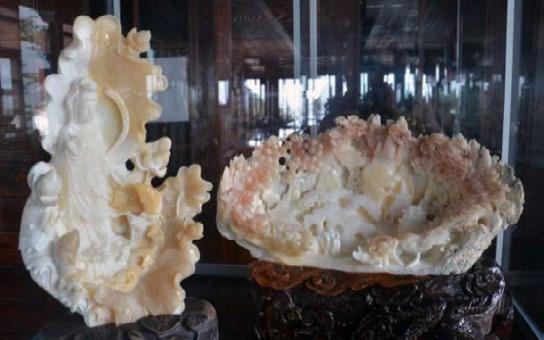
2 minute read
Introduction: Giant clam shell smuggling and organised crime
Although large-scale poaching and illegal trade of giant clams has occurred for several decades, the recent commercial-scale seizures of shells in the Philippines presents a new cause for concern. The largest seizure to date was reported in October 2019, consisting of 120,000 tonnes of shells with an estimated value of USD 39 million.6 It took place in General Santos City, the southernmost city of the Philippines on the island of Mindanao, which has a large fishing port and international seaport, and is centrally located in the Coral Triangle marine area. Philippine authorities have made at least another nine major seizures of shells since then, almost all in Palawan, the westernmost province situated between the South China Sea and the Sulu Sea. These seizures involved significant stockpiles of shells in strategic locations, and it is believed they were intended to be smuggled out of the country by boat.
The Philippines’ seizures have drawn the attention of the Wildlife Justice Commission as they indicate the possible involvement of organised crime, due to the level of logistics, organisation, and finance required to coordinate the collection and transportation of such vast quantities of product. As such, the Wildlife Justice Commission commenced the following research based on open-source information with a view to understanding some of the factors that may be driving the surge in the illegal clam shell trade.
Advertisement
Apart from the Philippines, the only other country that was found to have reported giant clam shell seizures was China. During the period from January 2016 to July 2021, China reported at least 46 cases relating to smuggling and harming giant clam shells, including illegal transportation, purchase, or sale. However, 96% of these cases involved small, retail-level quantities of shells and shell crafts, and only one case was found to be linked to the Philippines.
The majority of giant clam shells in China are believed to have been sourced from coral reefs in the South China Sea, and notwithstanding geopolitical tensions in this region, until now it could have been viewed as a “domestic issue” involving Chinese fishing fleets in the illegal harvesting of shells for the Chinese market. However, the recent seizures in the Philippines present the possibility that the trade may have taken on a transnational crime dimension.
Image 5: A National Bureau of Investigation agent inspecting the giant clam stockpile seized at General Santos City, October 2019. Credit: Jun Pulido.
Although the Philippines cases represent just one quarter of the total number of reported seizures identified during this period, the weight of the associated contraband corresponds to 99% of all giant clam shells or carved shell products seized during this period. The potential involvement of organised crime groups in the giant clam shell trade and the lack of major seizures occurring in locations other than the Philippines raises many questions that require further investigation to uncover the full extent of criminality, the smuggling routes, modus operandi, and the key facilitators behind the supply chain. Organised criminal networks are agile and have the resources to quickly adjust to new environments. Crime displacement can occur as organised crime groups adapt to strengthening law enforcement efforts, find new loopholes or weaknesses to exploit, or as demand for new commodities or opportunities for profits present. As such, it is vital that emerging trends are investigated and closely monitored to understand the criminal dynamics that may be at play behind it.











